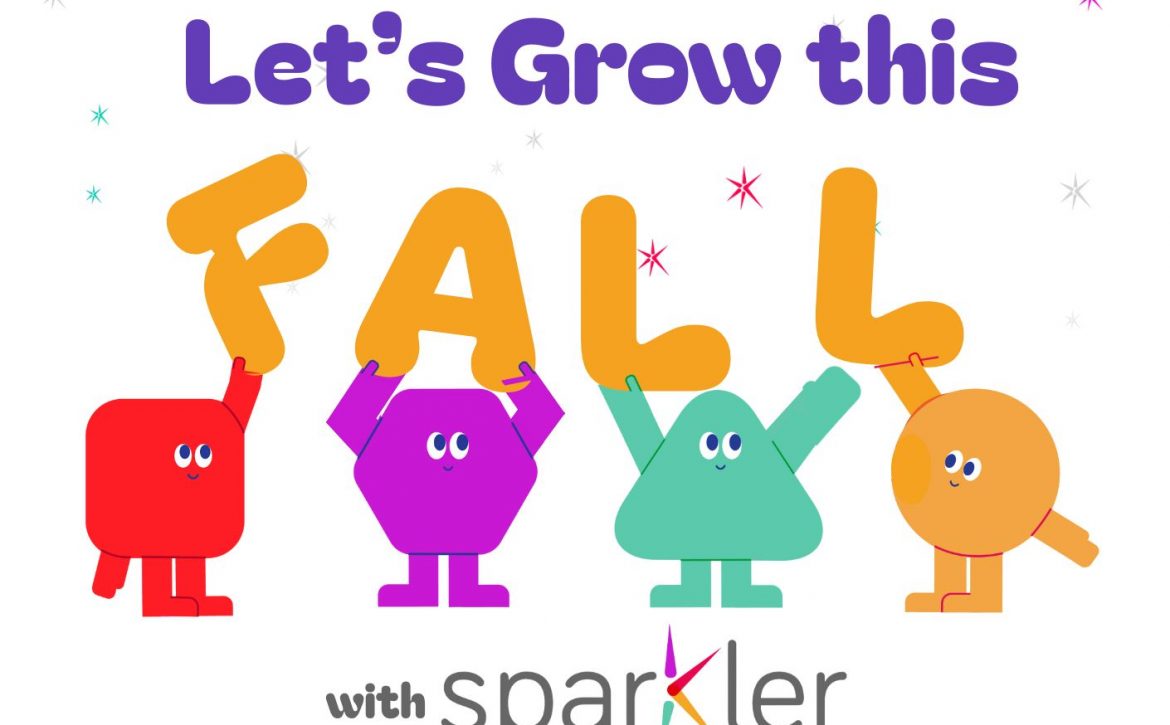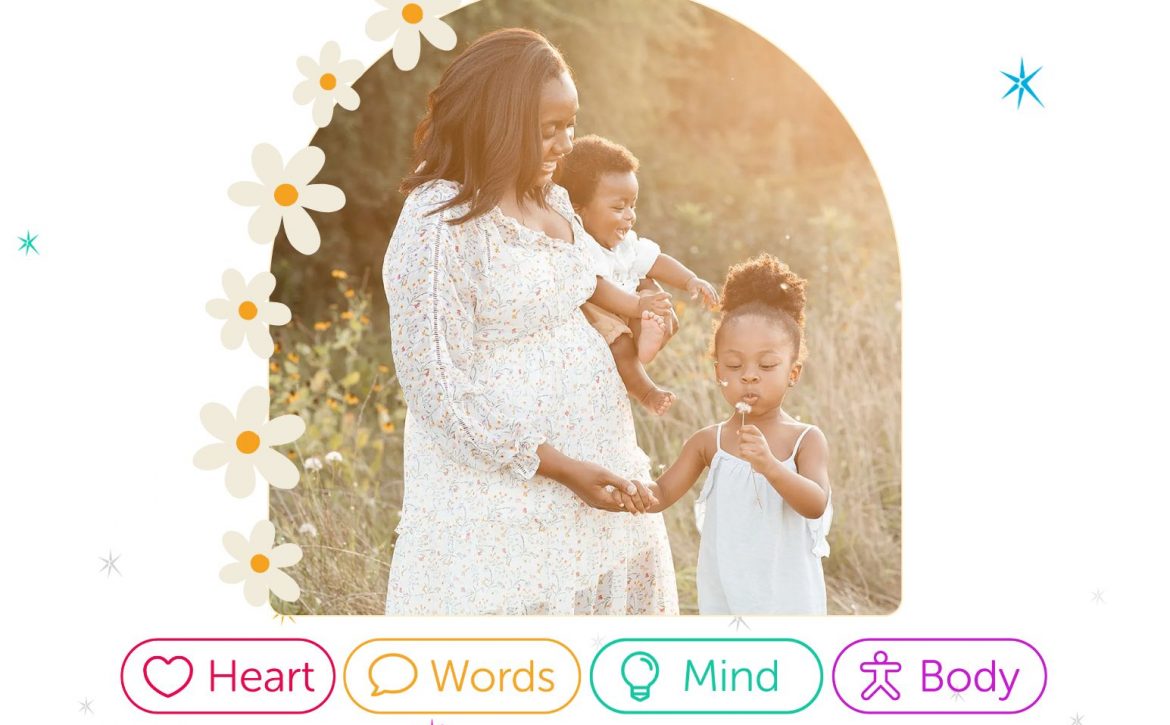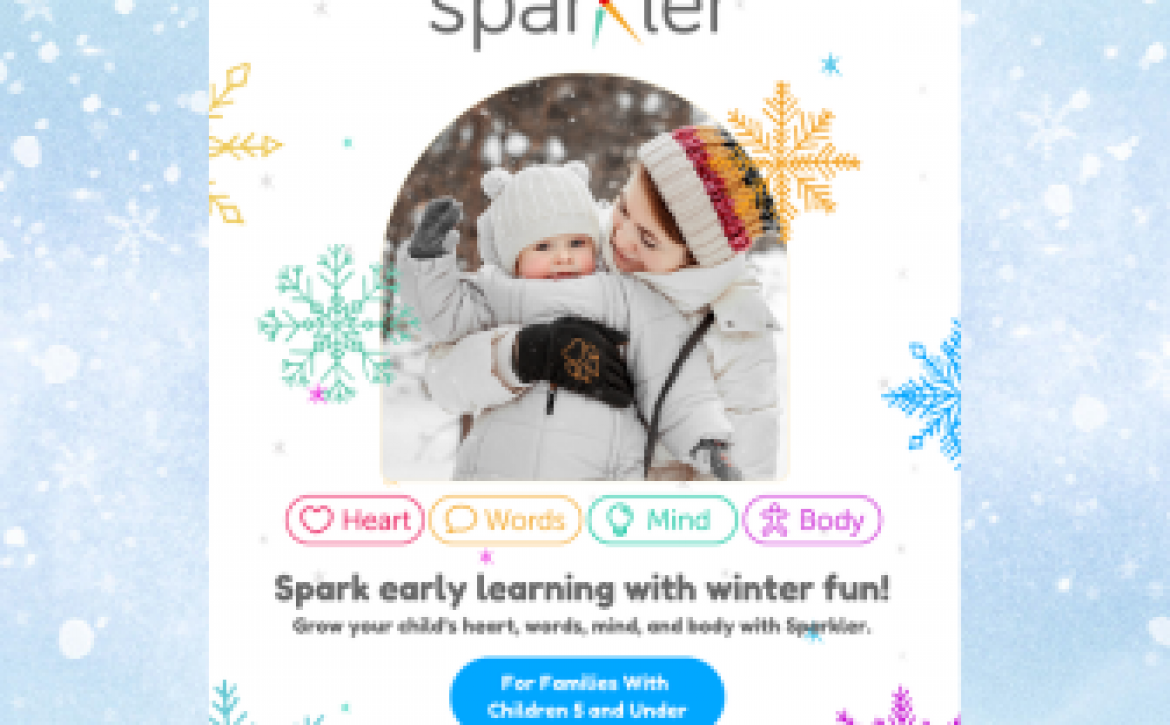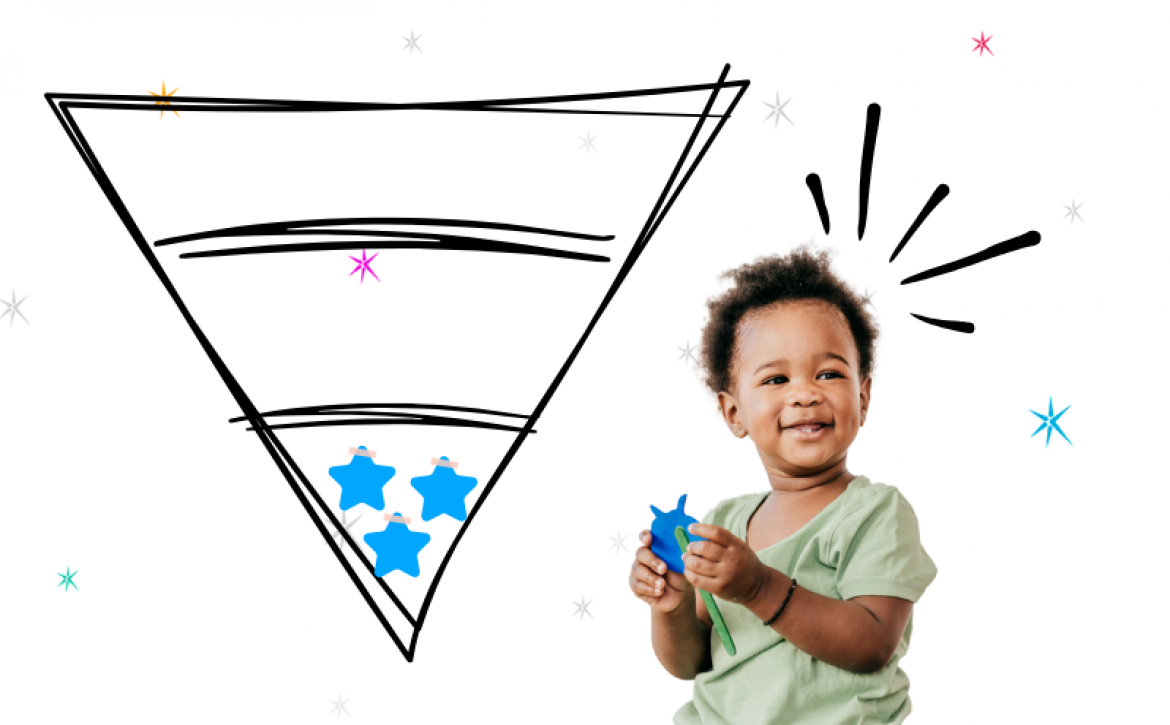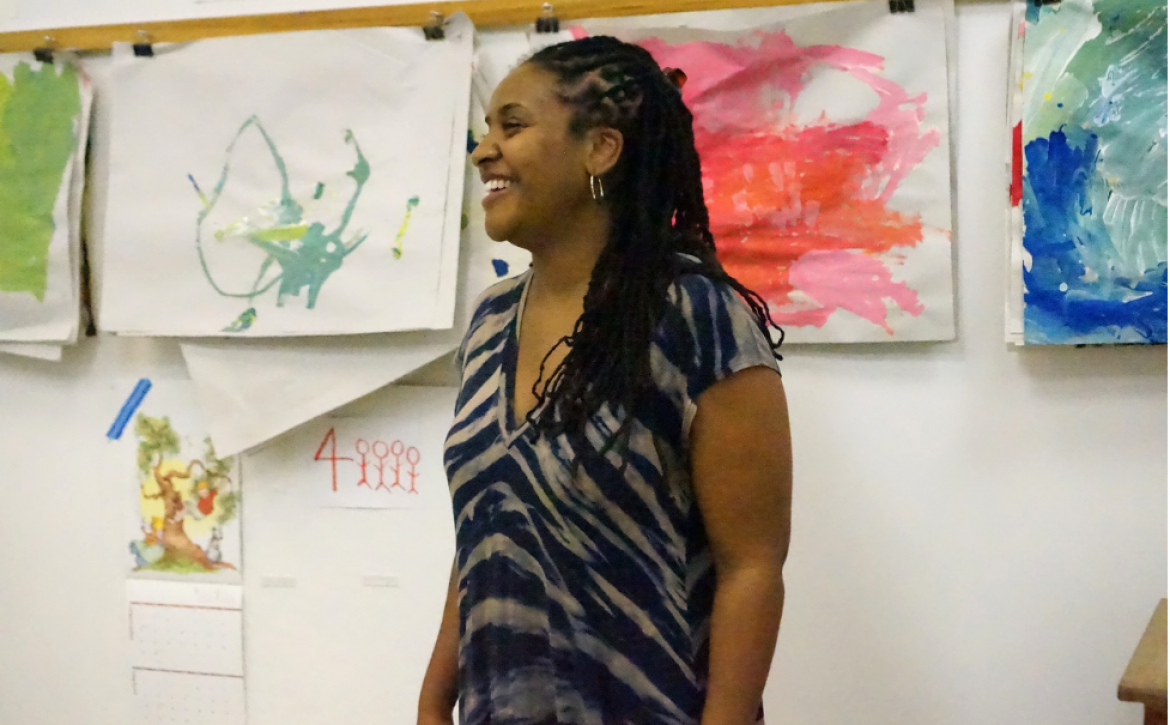Let’s Grow this Fall with Sparkler
Fall is full of opportunities to grow children’s hearts, words, minds, and bodies. Sparkler offers dozens of way’s to learn through play with young children this season. Here’s a new activity booklet that families can use to prompt play-based learning this season. We explore pumpkins, apples, pinecones, and more! Find even more in your Sparkler app.
Play throughout the spring with Sparkler! We created a special lineup of springtime activities that can spark spring play and help children reach important early learning milestones!
Playing together is one of the best ways to help your child learn and practice new skills. Sparkler has a growing library of fun, interactive play activities that you can do together, to help grow your child’s HEART, MIND, BODY, and WORDS.
Sparkler created a special booklet, full of winter play activities to help parents and caregivers find fun ways to play with their children to spark early learning and development. Parents and caregivers can scan the QR codes throughout the guide to link directly to Sparkler’s winter activities. Providers using Sparkler can use the Library to send suggested activities to families.
Sparkler has thousands of activities designed to help children (5 and under) build important early skills and spark passions. Here are a few (off-screen) Sparkler activities that can help families help their children practice gratitude. Families can find these activities in their Sparkler mobile app, and providers using Sparkler can share them with families via Sparkler’s dashboard. All activities are available in English, Spanish, and Chinese.
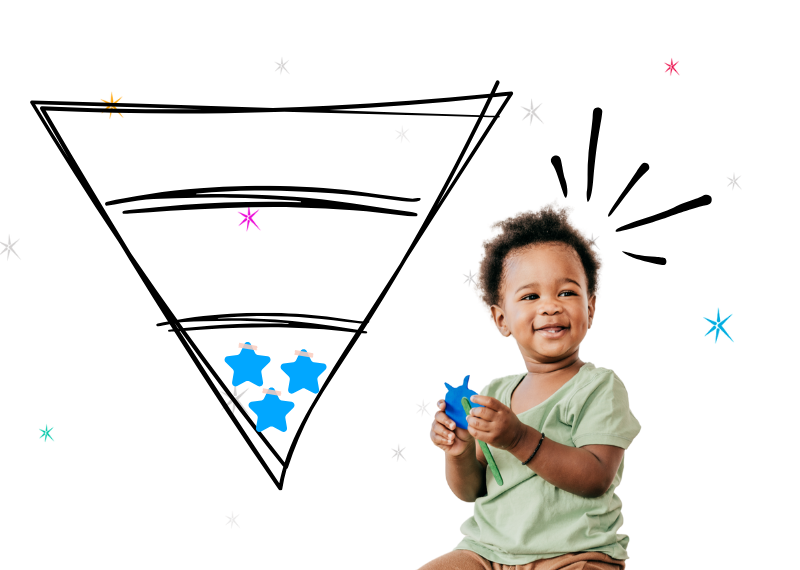
This is a collaborative game to share things we’re grateful for, played with a jar, plus paper and crayons/markers/pencils.
This is a family art project, creating and assembling a paper “quilt” of gratitude.
This is a craft activity that can help children to express gratitude.
Thank people in your community!
Make up a story about foods you love to express thanks for them.
Sparkler has thousands of activities designed to help children (5 and under) build important early skills and spark passions. Here are a few (off-screen) Sparkler activities that can help families help their children learn the building blocks of engineering and programming. Many of these activities include early math skills (like patterns and operations), and they also focus on children’s memory, problem-solving skills, and curiosity!
This is a coding game for littles that helps children give and follow instructions.
This is an invention game, using your MIND — plus your crayons and paper.
Start to understand patterns with this fun sorting game.
See what happens when you put paint on a ramp to grow children’s curiosity and focus!
Launch a ball into the air to build connection-making and self-regulation skills.
Drum and count the rhythm to start recognizing patterns.
Search for wheels to build focus and expression/storytelling skills.
For more than 100 years, researchers have been asking: What happens to student learning during the summer months? Researchers have found evidence of what educators call “summer slide,” “summer setback,” or “summer learning loss,” especially for children from low-income families (source).
These statistics are not destiny! Summer can be a time of growth, curiosity, exploration, and advancement! 2024 is the third summer of Sparkler Learning’s summer learning program — Camp Sparkler. Learn more about the program from Sparkler’s Education Director, Dana Stewart.
Sparkler: In your experience, is ” summer learning loss” real for preschoolers and young children?
Dana: Yes! I remember as a preschool teacher, we spend the whole year building up routines. By the spring, children are so practiced that they know exactly what to do in the classroom. If they go away for two weeks, and it’s like they never learned the routines. When we think about summer learning loss, we tend to think about older children and academic learning, but the same principles hold true for toddlers and preschoolers. They’re just learning different things in school.
Sparkler: As a mom and longtime preschool teacher and leader, can babies, toddlers, and preschoolers actually keep learning in the summer months?
Dana: Yes! In fact learning never stops with young children. I think that’s why it’s especially important for us — as caregivers of young children — to create opportunities for them to practice the skills that we want to promote throughout the year.
Sparkler: Why is the summer actually an important time for learning?
Dana: I think summer offers new opportunities for learning because a lot of us tend to slow down. The hustle bustle of the school year slows; children are less busy. This gives families opportunities to really dig into their children’s interests. We’re also outside more in the summer months, which gives children a chance to explore the natural world freely in a way that is more complicated when it’s colder outside. Summer can be an especially great time to involve children in sensory-rich activities like splashing in sprinklers, blowing bubbles, and playing in the sand.
Sparkler: Why have you built the Camp Sparkler program around stories?
Dana: Stories are amazing, stories are magic, stories connect people across cultures and around the world! Children are naturally drawn to stories, so they tend to be more engaging for young children, and the diversity of stories from various cultures offers lots of opportunity to explore different topics through play. Most people can’t get on an airplane and visit South America, Asia, and Africa over the summer, but through stories we’re able to give children a chance to go on this adventure and learn something about people and traditions from far away.
Sparkler: Sparkler emphasizes play — why is play important in the Camp Sparkler program?
Dana: Play is how children learn best. I think play is how everybody learns best. The physical experience of play is the best teacher. It’s the joyful self-directed practicing of skills that helps to crystalize new information. It generates new ideas and is the birthplace of creativity and ingenuity. The fact that play is FUN is maybe the most important aspect of play. We are motivated to play because it doesn’t feel like a chore. Playing WITH people you love is even better.
Sparkler: People are busy — how much time does a busy parent or caregiver have to spend playing with a child in order to make a difference?
Dana: The good news is that it doesn’t take much time at all. Even five or ten minutes a day can make a huge difference. The best is when you can spend a few minutes playing with your child and then set them up to continue playing, thinking, and processing independently for a few minutes.
Sparkler: What are some of the highlights of Camp Sparkler this year?
Dana: One of the things I’m most excited about at Camp Sparkler this year is the FAMILY TALES PROJECT, where we are encouraging children to listen to stories told by their grown-ups and turn them into a book of family lore. I’m excited to see the books that Sparkler families create this summer!
Sparkler: This will be your third summer leading Sparkler’s summer learning program. What brings you joy about Camp?
Dana: My favorite thing about camp is creating new play activities I’m really excited about and sharing those with families — and seeing their excitement as they play them together.
Sparkler: Will there be any new songs this year as part of Camp?
Dana: Yes! Last year, we had the Once Upon a Time song, which will be part of Camp again this year. We’ll also share about 3 new songs.
Sparkler: How can families access Camp Sparkler?
Dana: If a family already has a Sparkler account, they’ll start seeing camp activities on their app home screen on July 8, 2024. If a family doesn’t have a Sparkler account, they should create one, linking up with their local school or program and then they’re all set. Families can start anytime over the summer. It’s OK if they miss the first day or week. People can learn more on our website, and if there are other questions, just reach out to support@playsparkler.org.

As we wrap up 2023, we’re remembering the most popular Sparkler play activities of the year! We found activities that were PLAYED the most and also enjoyed by the children who played.
What were your top plays of the year? What will you play next?
Activity
Which Ages
Description & Skills
Cheek to Cheek
All ages
Dance close together (empathy, perception)
How Much do I Love You?
All ages
Show your love (perception, big muscle)
Kiss Kiss
Baby, Toddler
Snuggle & count kisses (counting, trust)
Heart Yoga
All ages
Open your hearts and breathe (big muscles, self regulation)
Stop, Drop, and Roll
Baby
Play together on the floor (perception, big muscle)
My Dream for YOU
All ages
Share your dream for your child (trust, persistence)
Read Together
All ages
Read together (sounds and letters, stories)
Appreciate the Earth
Baby
Take a walk and celebrate the Earth (curiosity, comprehension)
Stop and Smell
All ages
Smell nature (perception, expression)
Fall Walk
Baby
Observe the Fall (curiosity, perception)
Playground Fun
Toddlers, Littles
A day at the playground (perception, big muscle)
Light and Shadow
Baby
Play with a flashlight (perception, curiosity)
Night Walkers
All ages
Take a walk in the dark (curiosity, perception)
Shadow Theater
All ages
Make shadow shapes (big muscle, connection-making)
Spa Day
Baby
Moisturize your body parts (comprehension, connection-making)
Rip and Crinkle
Baby
Explore wrapping paper (perception, small muscle)
Do You Hear What I Hear?
Baby
Listen for sounds all around (comprehension, perception)
Bunny Hop
All ages
Hop like a bunny (big muscle, imagination)
Dance and Pull
All ages
Dance with a scarf (big muscle, trust)
Go See the World
All ages
Explore a new place together (curiosity, independence)
Dance It Out
All ages
Blow off some steam and dance! (Self-regulation, big muscle)
Jingle Jingle
Baby
Sing and shake your bells (small muscle, perception)
How the Beetle Got Her Gorgeous Coat: A Brazilian Folktale
All ages
Listen to the story (comprehension, stories)
Wrapping Paper Collage
All ages
Make art with paper scraps (small muscles, persistence)
Vroom Vroom
All ages
Listen and look for vehicles (sounds and letters, perception)
Families in San Francisco are invited to join the SF Department of Early Childhood and Sparkler Learning for 15 Days of Play — a special holiday initiative to promote fun and joyful play-based learning.
Who: San Francisco families using Sparkler with children 5 and under
When: From Nov. 23 to Dec. 8, 2023
How: San Francisco families who complete play activities in their Sparkler app can earn prizes while promoting human connection and learning across all the domains of development.
Prizes: Each time a family presses “We Did It” and shares a picture of a Sparkler activity, they earn 1 point. The top player will win a $150 prize, and the top 15 will win gift cards of $50. Families can repeat their favorite activities or play a new activity every day: The more they play, the greater their chances of winning!
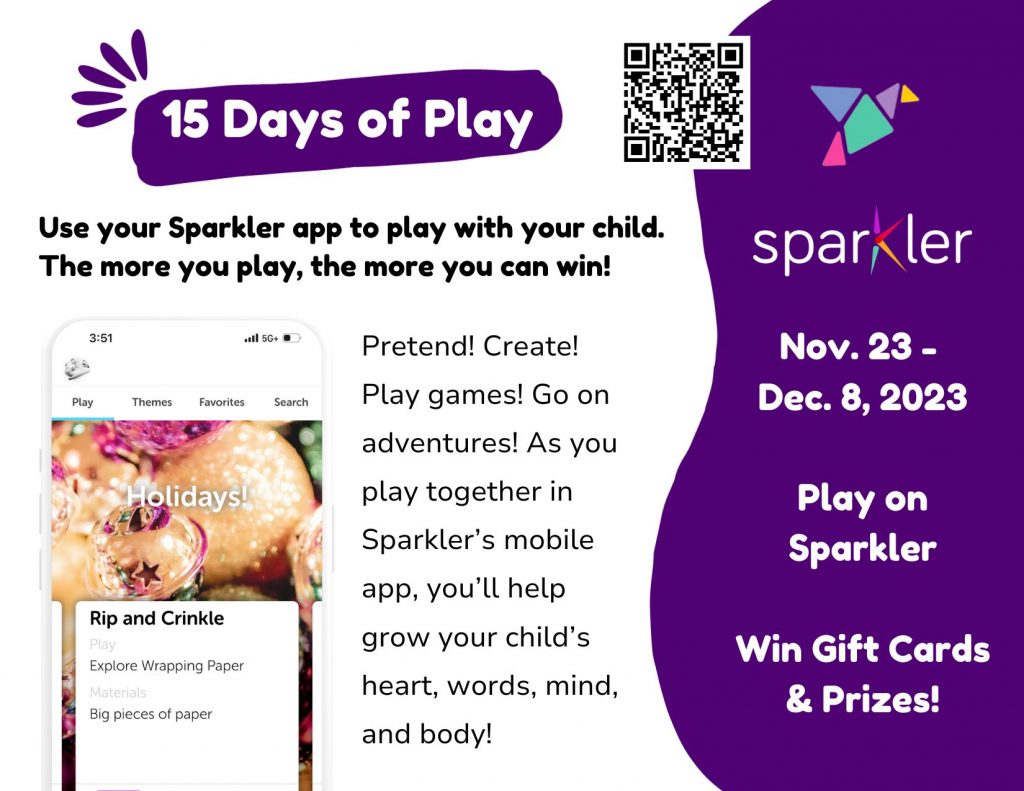
Sparkler spoke with Bethanne Vergean, who leads family and community engagement for Sparkler Connecticut and is the Learn the Signs Act Early ambassador for Connecticut, about the importance of ongoing developmental screening and promotion in the early years.

Developmental screening is a quick snapshot of your child’s developmental progress. Screening helps parents and providers to better understand children’s early growth and learning: Which skills have they developed? Which ones might need a little more practice or support? It’s estimated that 1 in 7 children are affected by developmental delays or other related challenges, but only about 1 in 5 of those kids gets identified before school begins. The earlier and the more that we screen, the better we can get at identifying which kids might need early interventions.
Developmental monitoring is done by families and caregivers every day as they watch their child play, speak and move. Screening is a more formal process, using a validated tool like Ages & Stages Questionnaires, but both are important. We’re so excited to be sharing Sparkler with Connecticut families because it brings together monitoring, screening, and ongoing promotion, making it easier for families to track and support their children’s development in the early years.
Learn the Signs is a program from the CDC (Centers for Disease Control and Prevention) that aims to improve early identification of children with autism and other developmental disabilities so children and families can get the services and support they need as early as possible. Learn the Signs shares checklists of the skills that most children develop at each age in early childhood. Parents can find these checklists in Sparkler’s app under Tips for Adults to check on what skills their children should develop between birth and age 5.
As early as possible! The first ASQs are for two month old babies! Ideally families will complete these questionnaires throughout their child’s early years to understand their development, celebrate the milestones they achieve, and have the info they need to support them.
Everyone! Studies show that people — even experts — aren’t great at identifying delays if they are not using screening tools. When everybody screens, parents and providers have the information they need to know who might need extra support! The exception to this rule is families who have children who are already diagnosed with delays. If a child is already receiving early interventions, there’s no need to complete more screening. (Families can still use Sparkler to find fun learning activities to play together, regardless of a diagnosis!)
Children learn and grow so much — and so quickly — in the early years! The skills they develop in the first five years help them get ready for everything that comes later — succeeding in school, navigating friendships, playing on teams. Screening early and often throughout early childhood helps families understand and support their children’s learning along the way.
Yes! Screening helps parents learn what their children can do. When they try the skills in the ASQ — like walking up steps or drawing straight lines — parents are often surprised at all of the amazing skills that their kids have developed. Completing the screening can also help parents articulate questions or concerns they have, setting up really valuable conversations with their teachers or other providers.
PLAY! Plain and simple play is the most powerful tool we have to help children learn and grow in the early years. Playing games, pretending, creating, going on adventures, singing, talking: all of these playful moments in children’s days are helping them develop important skills. Parents can use Sparkler to find thousands of play activities that can help them play and learn with their children.
Connecticut is the birthplace of Help Me Grow, a national system of early support that helps parents with young children. One important part of Help Me Grow is having a centralized access point for parents — a hub where families can get information and tools to help their kids if they have concerns in the early years. In Connecticut, that access point is 211 Child Development — and Sparkler connects parents directly with 211. If a parent asks a question in Sparkler’s two-way chat, they can get follow up and support from a care coordinator at 211; if they have a concern about their child’s development and are looking for what to do next, they can reach out to 211 through Sparkler. By putting Sparkler in parents’ pockets, we’re expanding access to the support that all parents need and deserve. It’s hard to be a parent. We never have all the answers! Sparkler is a tool that makes it easier for parents to access the answers and help they need.
I have been working in Early Childhood for 20 years! Early in my career I experienced working with families and young children by providing Health and Developmental screenings. This opportunity brought me such joy to work with families and guide them on the development of their children. Being the Learn the Signs Act Early Ambassador, I have had the opportunity to travel around the state and provide training to healthcare professionals, state agencies, home visitors, and early childhood programs. It is even more exciting now that I can share my work as an Ambassador and being a part of the Sparkler team to ensure that families have greater access to the information and resources they need to help their children.

